
Boronia muelleri, commonly known as the forest boronia or pink boronia, is a flowering plant that occurs in forest, woodland and heath in Victoria and New South Wales in Australia. It is an erect, woody shrub or small tree with pinnate leaves and up to fifteen pink to white four-petalled flowers arranged in leaf axils in spring and summer.

Zieria aspalathoides, commonly known as the whorled zieria, heath zieria, hairy zieria or heathy zieria, is a plant in the citrus family Rutaceae and is endemic to eastern Australia. It is a heath-like shrub with leaves that appear to be whorled and with pink flowers in groups of three, each with four petals and four stamens.
Zieria furfuracea is a plant in the citrus family Rutaceae and is endemic to eastern Australia. It is a shrub with three-part leaves and groups of large numbers of small white flowers, the groups shorter than the leaves. It grows on the coast and tablelands north from Wyong.

Boronia edwardsii, commonly known as island boronia, is a plant in the citrus family, Rutaceae and is endemic to South Australia. It is a small, erect shrub with trifoliate leaves and pink or white flowers with four petals and eight stamens. It is common on Kangaroo Island but rare on the mainland.
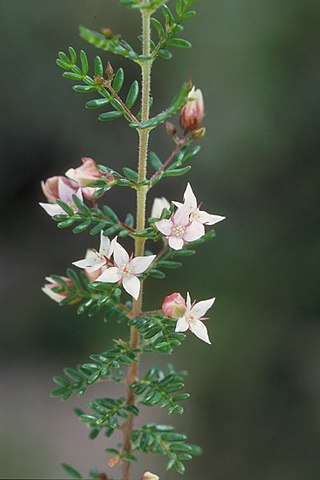
Boronia alulata is a plant in the citrus family, Rutaceae and is endemic to Cape York Peninsula. It is an erect shrub with many branches, pinnate leaves and pink or white, four-petalled flowers.
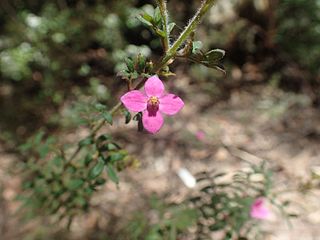
Boronia gracilipes, commonly known as karri boronia, is a plant in the citrus family, Rutaceae and is endemic to the south-west of Western Australia. It is an erect, spindly shrub with compound leaves and pink, four-petalled flowers.

Boronia latipinna, commonly known as the Grampians boronia, is a plant in the citrus family Rutaceae and is endemic to the Grampians in Victoria. It is an erect, woody shrub with pinnate leaves and pink or white, four petalled flowers.

Boronia pulchella, commonly known as the pink boronia, is a plant in the citrus family Rutaceae, and is endemic to a small area in the south-west of Western Australia. It is a slender shrub with rod-like stems, pinnate leaves and deep pink, four-petalled flowers.

Cyanothamnus rigenss, commonly known as the stiff boronia, is a plant in the citrus family Rutaceae and is endemic to south-eastern New South Wales in Australia. It is a low, compact shrub with mostly trifoliate, glandular leaves and white to pale pink, four-petalled flowers in the leaf axils.
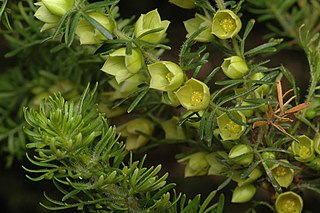
Boronia tetrandra, commonly known as yellow boronia, is a plant in the citrus family, Rutaceae and is endemic to Western Australia. It is a spreading or erect shrub with hairy stems, pinnate leaves and greenish cream to yellow or reddish brown, cup-shaped, four-petalled flowers.

Boronia capitata, commonly known as the cluster boronia, is a plant in the citrus family, Rutaceae and is endemic to the south-west of Western Australia. It is a slender, spreading shrub with simple leaves and pink, four-petalled flowers.
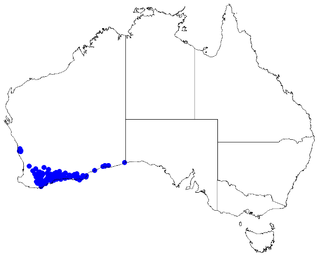
Boronia crassifolia is a plant in the citrus family, Rutaceae and is endemic to the south-west of Western Australia. It is a small, slender shrub with pinnate leaves, and yellowish green to brownish, four petalled flowers.

Boronia crassipes is a plant in the citrus family, Rutaceae and is endemic to the south-west of Western Australia. It is an erect, spindly, glabrous shrub with simple leaves, and pale red or pale mauve, four petalled flowers.
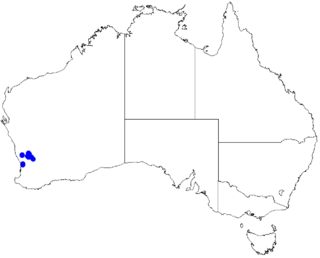
Boronia ericifolia, commonly known as Wongan Hills boronia, is a plant in the citrus family, Rutaceae and is endemic to the south-west of Western Australia. It is an erect, densely branched shrub with trifoliate leaves and pink, white or creamy yellow flowers with four petals and eight stamens only known from near Wongan Hills and Moora.

Boronia filicifolia is a plant in the citrus family, Rutaceae and is endemic to the far north-west of Australia. It is an erect or sprawling shrub with many branches, pinnate leaves with up to 55 leaflets and white to pink flowers with the sepals a similar length to the petals.

Cyanothamnus inconspicuus is a plant in the citrus family, Rutaceae and is endemic to the south-west of Western Australia. It is a shrub with pinnate leaves and small white or creamy green flowers with four petals and eight stamens and occurs from the Stirling Range to Mount Ragged.

Boronia oxyantha is a plant in the citrus family, Rutaceae and is endemic to a small area in the south-west of Western Australia. It is a shrub with many hairy branches, pinnate leaves and pink, four-petalled flowers that have a darker midrib.

Cyanothamnus penicillatus is a plant in the citrus family, Rutaceae and is endemic to the south-west of Western Australia. It is a low, spreading shrub with pinnate leaves and white flowers with four petals and eight stamens.

Boronia stricta is a plant in the citrus family, Rutaceae and is endemic to near-coastal areas of the south-west of Western Australia. It is a slender shrub with often crowded pinnate leaves with linear leaflets, and pink, four-petalled flowers borne singly or in groups of two or three in leaf axils.

Boronia wilsonii is an erect shrub that is endemic to northern Australia. Its branches, leaves and backs of the flowers are densely covered with woolly hairs. The petals are white to pink or burgundy-coloured.




















